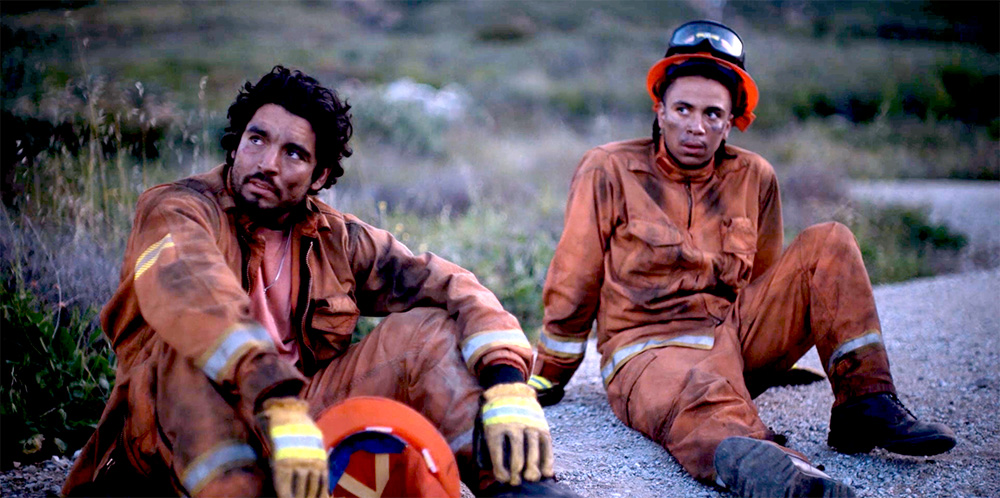
Picture courtesy of London Flair PR.
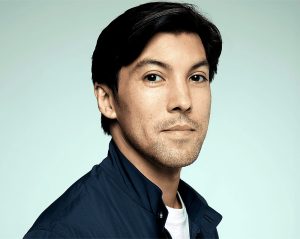
Director Robin Takao D’Oench. Picture courtesy of Indeed Rising Voices
His tour de force has been selected for consideration to compete in the 2024 Oscars. It’s a 12-minute short about incarcerated prison inmates who serve as firefighters in a special incarceration program and the film has garnered significant critical acclaim, including winning a VFX award.
{Visual Effects, sometimes abbreviated VFX, is the process by which imagery is created or manipulated outside the context of a live-action shot in filmmaking and video production. The integration of live-action footage and other live-action footage or CGI elements to create realistic imagery is called VFX.}
D’Oench’s credentials for making short films that explore themes of incarceration and immigration are impressive. His muse for coming up with ideas and plans includes drawing on his family’s history of being interned in Japanese-American internment camps during World War II. For FIRELINE, D’Oench assembled a cast that included many formerly incarcerated prisoners. He and his crew did that, he says, in order to add an extra level of authenticity for his film.
Audiences expect the best films to have verisimilitude that can make them feel as if they are flies on the wall. The verisimilitude in FIRELINE, however, is transcendent, resulting in production values that convincingly captures the intensity of what it’s like being engulfed in a fiery landscape. D’Oench credits his cinematographer, Ming Jue Hu, for this breathtaking aspect.
D’Oench is New York born and currently based in Venice, California, where he lives with his wife and their first child. He says he has a strong interest in telling stories about institutions and the gray areas they operate in.
Q&A Edited for Context and Clarity
the WORD (Gregg W. Morris): Thank you for the opportunity to interview you. I’m a little sloppy with this interview by ZOOM we’re doing. I just want to make sure I’ve done (technically correct) everything I’m supposed to.
I want to pop out this question real quick before we get into the in-depth interviewing. What happens after incarcerated wildlands firefighter Otto Reyes, played by Bobby Soto, is returned to his prison cell at the end of the big firefight? {For audiences yet to see this marvel: Reyes had recently been denied parole and was desperately trying to call his daughter while he and his crew fought the fire. Reyes, like his teammates, was heroic , yet, his being returned to prison without connecting with his kid and still shaking off the heebie-jeebies that comes with doing the job right situation had a really poignant effect on this reviewer.}
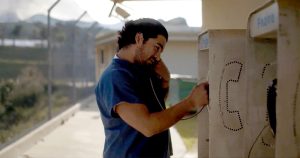
Otto Reyes played by Bobby Soto. Picture courtesy of London Flair PR
Director Robin Takao D’Oench: Okay, so I referred to the film throughout the writing process and the development process as a sort of a Sisyphean journey where, if you’re familiar with the story of Sisyphus, he is sentenced to push this boulder up a hill, and then, as soon as he gets the boulder up to the hill, he’ll turn around and the boulder’s back at the bottom of the hill and they just go back down and then push it up the hill again.
And so that’s how I viewed prison labor, it is in the sense a job that is never done. And as soon as prisoners completed the task, the authorities give them another one, the idea being that the job is never done and that as soon as one task is over another begins.
the WORD: Based on my experience, when viewers watch your film, they’re going to be seized, mesmerized by what is unfolding on the screen. It’s amazing they, me, can become so easily mesmerized and so quickly in a film that is only 12 minutes long. How did this film come about?

Otto, played by Bobby Soto. Picture courtesy of London Flair PR
Director Robin Takao D’Oench: So the genesis of this came about that way through the Indeed Rising Voices program which wants visions of the future of work. And in looking towards the future of work, I pulled for inspiration from the pas, and I was inspired by Chinese American railroad workers, Irish indentured servants, and an entire labor system that stems from American slavery. And then what does that look like in a modern context?{Editor’s Note: Click here for more info about Indeed click here.}
On top of that, a month before I started writing, I was in New York where I’m born and raised, and the sky turned this bright, vibrant orange that we’d never seen before. And it was the result of a wildfire in Canada. And for me it was this moment of thinking of regardless of what we feel about climate change, we are now in this new chapter of how we live with our environment and our climate.
And so, again, all of these factors were part of this genesis. And then as far as my entry points into the emotional side of the story, as far as a father trying to call his daughter, my wife was six months pregnant when I started writing, and so I was going to be a father. And so all of these elements came together to make this piece.
{Note: Director D’Oench was born in Brooklyn. Went to high school in Bay Ridge. Lived in Manhattan for a little more than a decade and after college (NYU) he lived in 13 different neighborhoods in Queens, Brooklyn (Carol Gardens) Chinatown and Washington, Heights. He studied film at the Tisch School of NYU. As an undergraduate, he “was working as a PA (production assistant) when he was in high school. I was very lucky to get on a couple sets and I didn’t really have great grades. And I made a deal with my mother that if I got into a four-year film school, or specifically NYU, I would go. And so through some sort of luck I got into NYU.”}
I’m really interested in movies about institutions. I have a fascination with films that revolves around, not to say so much politics, but formal institutions in the gray areas that they exist in. My grandparents were both interned in Manzanar and Rohwer internment camps.
And so I, because I have this familial history of incarceration, it is something that has always been a source of interest and inspiration when it comes to storytelling. So I’ve pulled from storytellers like Sidney Lumet and Costa-Gavras as far as impact storytelling is concerned.
{Impact storytelling is the art of crafting narratives that not only convey information but also evoke empathy, provoke thought, and compel action. Unlike traditional storytelling, which may focus solely on entertainment or information dissemination, impact storytelling wants to invoke meaningful change.}
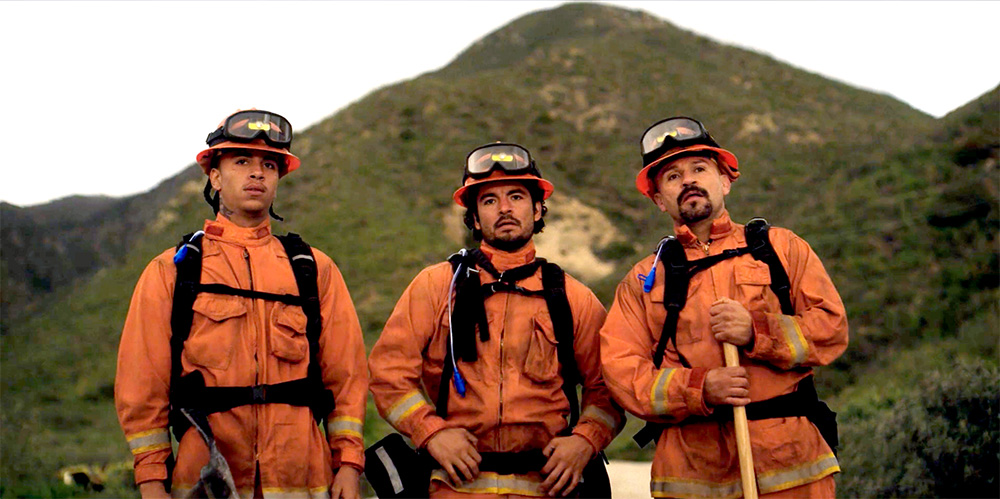
Picture courtesy of London Flair PR.
the WORD: This movie is about firefighters and these are guys are incarcerated and the way it is done in California, they’re sort of farmed out or slaved out … risking their lives?
Director Robin Takao D’Oench: That’s a good question. So I started with the search for the actor who would play Otto, and Bobby (Sotto) was sort of always at the top of my list. And what I was looking for and what I find myself often looking for in actors is, who are they outside of just the performance?
And I came across this interview that he gave about a film that he had written and his own personal relationship to incarceration. He himself has never spent time in prison, but members of his family have. And something that people will often say, is, when you do time, your family does time. And Bobby and I met. We met for over lunch and we just started talking. We were sharing our inspirations, our dreams, our sort of goals, and what brought us to this work.
And then halfway through the conversation, he just puts his hand over the table and goes, “I’m in.”
And from there, it just became this sort of partnership and this friendship of trust. And we would text each other, call each other and just talk about the character, talk about where is this person in his own life, where is he coming from and where does he want to go?
And then from there we sort of built out the rest of the cast. One thing that I was really intent upon, and I think our casting director, Matt Maisto, did a fantastic job with, was almost half of our cast are formerly incarcerated themselves, especially in the Ensemble. And so we were looking for a specific type of authenticity and to bring to the screen.
And as far as building a camp, I told the producers. I was like, “We’re going to find this location. It’s going to have the prison camp, and then in the same area it’s going to have a forest and everything’s going to be right next to each other.” And then I got off the call… maybe. And then they’d say, ‘How are you going to do the fire?’
I’d go, ‘Oh, it’s easy. It’s easy. We’re going to use light and we’re going to use smoke. And then we’ll do all the fire as visual effects. And so we’ll have no real flames. It’ll just be like on set. It’ll be light and actual smoke.’ And then I get off the call and I go, I don’t know, maybe. But that’s exactly what happened. We found this location up in the mountains just within Los Angeles. And when we did the fire, we had an incredible SFX team that brought all this live smoke into the valley that we were shooting in.
My cinematographer, Ming (Ming Jue Hu) was able to get these specific lighting units that you’ll see in 1917 (2019) and James Bond’s SKYFALL (2012). And where they’ve got 30 of them, we had two of them and they replicated, sort of, our flames. And then our incredible VFX supervisor, Celeste (Leizer), who recently won an award at HollyShorts, created this incredible tapestry of flame.
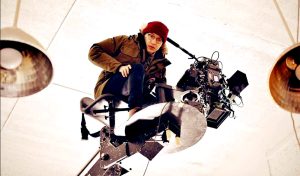
Cinematographer Ming-Jue-Hu. Picture courtesy London Flair PR

Celeste Leizer.
the WORD: It looked like they were in the middle of a fire and about to be consumed. I had to watch it twice. I get into it, then I get to see it again and see what I miss. I swear to God, it looked like they were in a fire. And I was wondering, so particularly this like… I’m sorry, go ahead.
Director Robin Takao D’Oench: My cinematographer’s father saw the movie and after he saw the movie, he goes to him and he goes, “Ming, it’s not worth it.” He goes, “What are you talking about?” He goes, “It’s too dangerous. You’re too close to the flames. It’s too dangerous. You don’t need to risk your life to make these movies.”
And he looks at him and goes, “Dad, it’s all fake.” And so I think that’s one of my favorite stories of just like… And this is why I think it was so special that we won the VFX award, is when VFX are done really, really well, you don’t know that it’s fake.
the WORD: Okay. I could almost feel the flames or the fear… as well as the fear of the flames. So I’m going to be jumping around a little bit. Are you working on a regular feature length movie similar to this film? If you don’t want to talk about it, that’s okay but…
Director Robin Takao D’Oench: No, we’re looking to expand it into a feature film. We’ve got this incredible momentum behind it. We have the awards campaign going on right now. The response to the film has been incredible. Everyone who’s seen it has been really excited about it. And so all I can say at the moment is that things are cooking and, 100 percent, we want to bring this to a bigger screen and a bigger audience.
the WORD: Okay. I’m not trying to get you to say something you don’t want to say. I’m just nosy. How long would that take for you to start making your movie? Can you… I know it’s …
Director Robin Takao D’Oench: From now until the movie plays in a movie theater, or from now until we’re on set making the movie?
the WORD: Both.
Director Robin Takao D’Oench: So if it was …
the WORD: Or either one. I’m just so nosy. Sorry.
Director Robin Takao D’Oench: No, no, no. I don’t think that’s nosy. I think that’s a very legitimate question. I had a roommate in college who was a musician and he was a rapper, and we were living in Parkside Avenue to south of Caroline Heights. And in his room, in his closet, he made a studio booth. So he had all the makings to record. And he would go into the booth and just he would rap and then come back. And then on the computer, he put the song together and then the next day he would have a track.
And I said to him… I go, “From artist to artist, I’m really jealous. “He goes, “What are you talking about?” And I go, “The fact that you can output so quickly is something that I would love to be able to do. But for what we do as filmmakers, it requires so much more time and more people.” Even when you write something, it’s never finished. You go shoot it, it’s not finished. The process, from our conversation now to the movie screening in a theater could be two, three plus years.
I had a mentor say to me, “When you make a movie, make sure the people that you’re bringing onto that film are people that you’d want to spend the next two years of your life with.”
the WORD: Okay.
Director Robin Takao D’Oench: And so I would say at the fastest, it would be two years.
the WORD: You won a lot of awards and you’ve made a lot of stance. There was this one… [inaudible 00:19:27] this one right here. Sorry. Oh, here it is. I’m going to mispronounce this. I want to make sure I get this though. Tadaima?
Director Robin Takao D’Oench: Tadaima.
the WORD: Tadaima. Was that a regular feature? It’s not clear from my notes.
Director Robin Takao D’Oench: That was also a short film. That was made almost 10 years ago. Actually, no, the film was shot 10 years ago, but it came out in 2015. So that was 10 years ago.
the WORD: Can you tell me a little bit about the story?
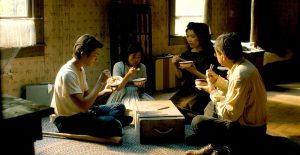
Click here for Part 3 of 3

Publisher, Editor Gregg W. Morris